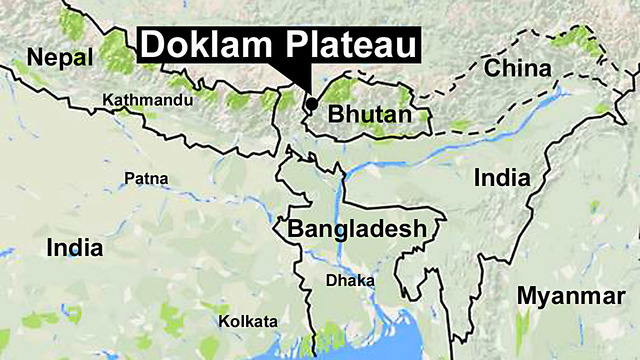BY JABIN T. JACOB (2 SEP 2017) – The standoff between China and India in the Doklam area of Bhutan has been resolved with each government putting out differing versions of the exact terms of the settlement. But it is certain that the status quo from before June 16 this year has been restored. The Chinese have stopped road construction in the area, which had led to the Indian action in the first place and Indian troops have pulled back to their positions.
The Chinese government has sought to sell the deal as a case of the Indians having blinked, of bowing to Chinese threats and coercion. It is doubtful the line has much purchase even within mainland China, where the netizen community might have constraints on their conversations but are not stupid and not entirely without access to information from the outside world.
 What then explains China’s high-decibel campaign of vilification against India in the wake of the standoff and which shows no sign of letting up even now? The issue is worth examining for what it says about the future direction of India-China relations.
What then explains China’s high-decibel campaign of vilification against India in the wake of the standoff and which shows no sign of letting up even now? The issue is worth examining for what it says about the future direction of India-China relations.
It is a little-noticed reality that ordinary Chinese view India somewhat differently than they do other major global powers. While there is a template of nationalist rivalry with Japan and another of a larger, geopolitical rivalry with the United States, neither template fits the relationship with India.
India has, in recent years, built up a growing profile in China especially through the popularity of yoga and its films. The Indian sports drama Dangal that showcased the relationship between a strict father and his daughters was a hit this year in China with its similar problems of patriarchy and parental pressures on children. Indian Prime Minister Narendra Modi’s promotion of yoga across the globe and of India, as a sort of cultural and spiritual superpower has had some impact in China, too.
India’s influence is also evident in other, perhaps, more important ways, in China. Notably, these include its identity as the world’s largest democracy and in the popularity of Mahatma Gandhi among intellectuals and civil society activists. The interest in Gandhi’s methods of non-violent struggle specifically, is not surprising given the constraints on civil society and on political activity in China.
The Communist Party of China, already actively battling apparent Western influences in its politics and educational institutions, is unlikely to look at these forms of Indian influence in a positive light.
India’s muscular response to China’s bullying of the Bhutanese in the Doklam area was, therefore, also an opportunity to counter any positive images of India building up in Chinese society, no matter that not many Chinese really paid much attention to Doklam compared to goings-on in the Korean peninsula or the South China Sea.
India-China relations are almost certainly entering a new phase marked by greater hostility and suspicion between the governments and militaries, certainly, but worryingly also now, it seems, at the popular level, if the Chinese government’s campaign is anything to go by. For its part, India, too, has seen repeated – and wrong-headed – calls for boycotting Chinese goods.
To their credit, many Indian analysts have been very sober in assessing the outcome of the Doklam standoff, refusing to crow about the apparent victory. They are well aware that China found itself in a difficult location in military terms at Doklam and that elsewhere on the long disputed boundary between the two countries, the Chinese have locational and logistical advantages that can put the Indian military under pressure.
Doklam will count only as part of the initial series of incidents – alongside those at Depsang in 2013 and Chumur in 2014, both along the Line of Actual Control in the western sector of the disputed boundary – that mark a change in the nature of engagement between the Indian and Chinese militaries and governments. This is the result of the rise in economic strength, military capabilities, and regional and global political ambitions of the two countries. And it calls for a re-evaluation of existing bilateral agreements as well as negotiations on the boundary, if bilateral ties are not to deteriorate.
Meanwhile, the challenge in India is to look at China more holistically as more than a security and/or economic challenge. As China’s early attempts to turn the narrative on India both within China and in the neighbourhood show, there is an ideological and political challenge that it perceives from India.
Many ordinary Chinese know India to be a democratic country but also point out that it is ‘chaotic’, ‘dirty’ and ‘poor’. But if such a country can also grow faster than China, its citizens also possess political liberties, and, to top it all, is also now capable of standing up to it militarily, then the consensus about India being democratic but ‘ineffective’ or unable to catch up with China will eventually crumble.
India, of course, cannot change its identity as a democracy, something Indians are justifiably proud of, but New Delhi must understand the implications of Beijing’s actions and work doubly hard to prevent a fraught security relationship with China from also turning into one where suspicion and prejudice dominate also at the people-to-people level. And Beijing, if it knows what is best for its own standing in Asia and the globe, will do likewise. ■
Jabin T. Jacob, PhD is Fellow at the Institute of Chinese Studies, Delhi, India. This article first appeared in South China Morning Post.


